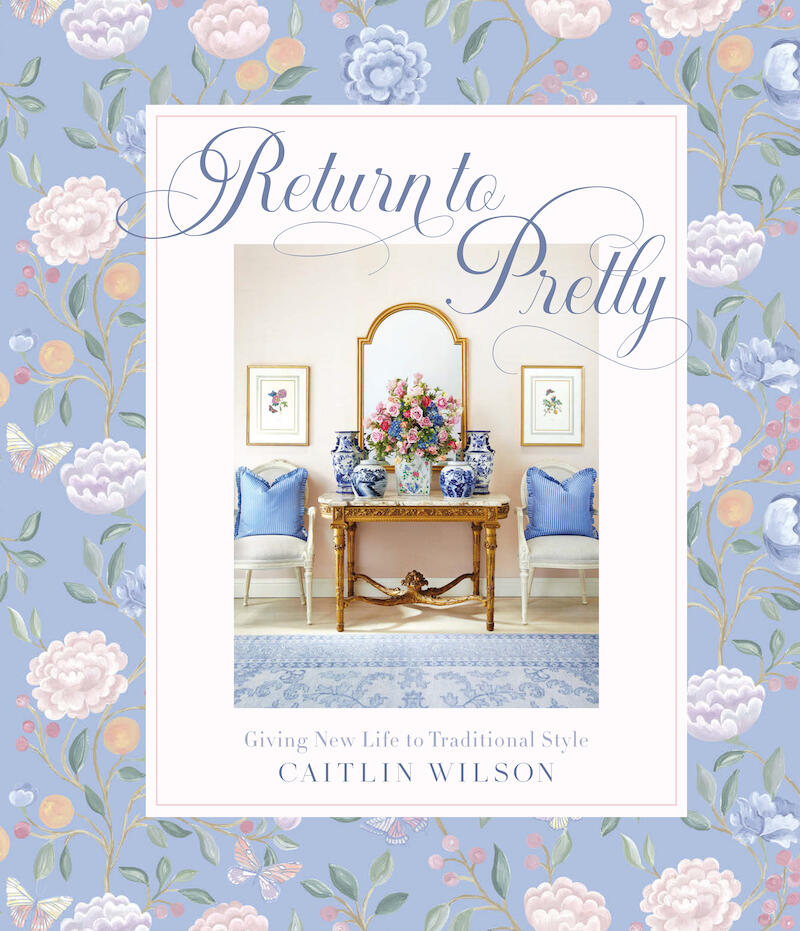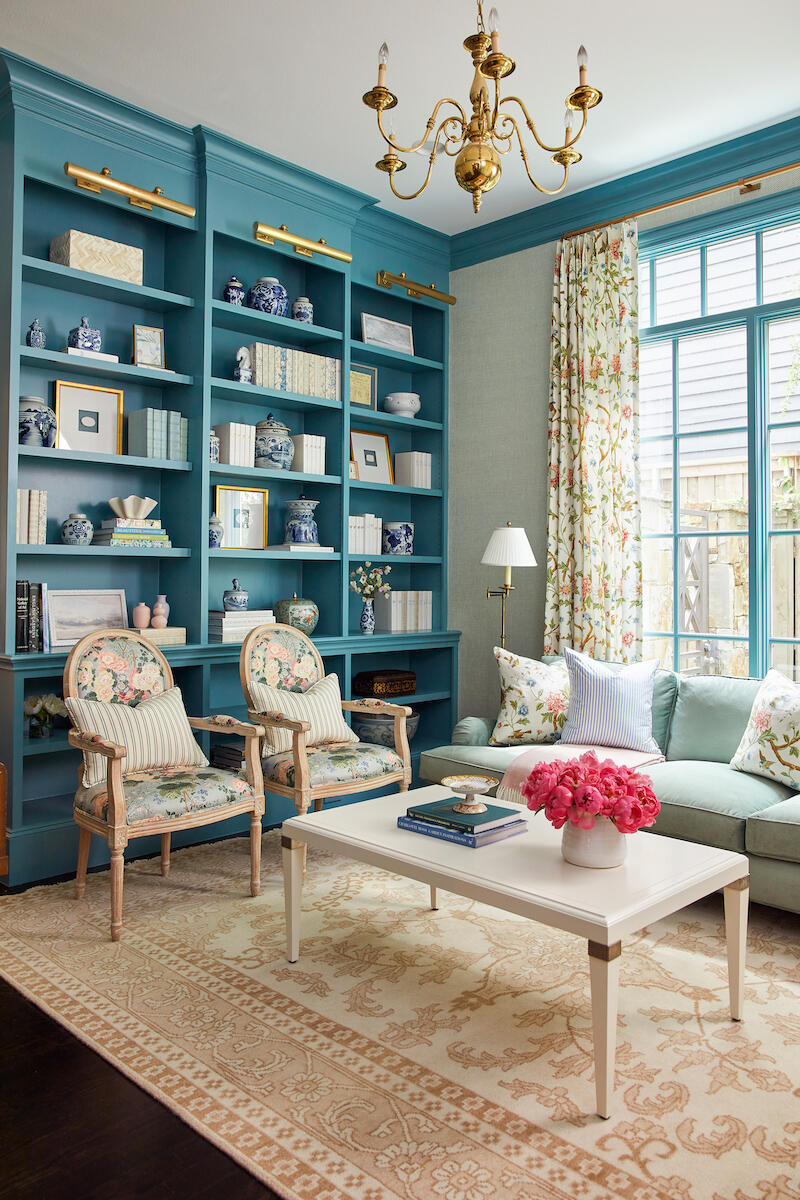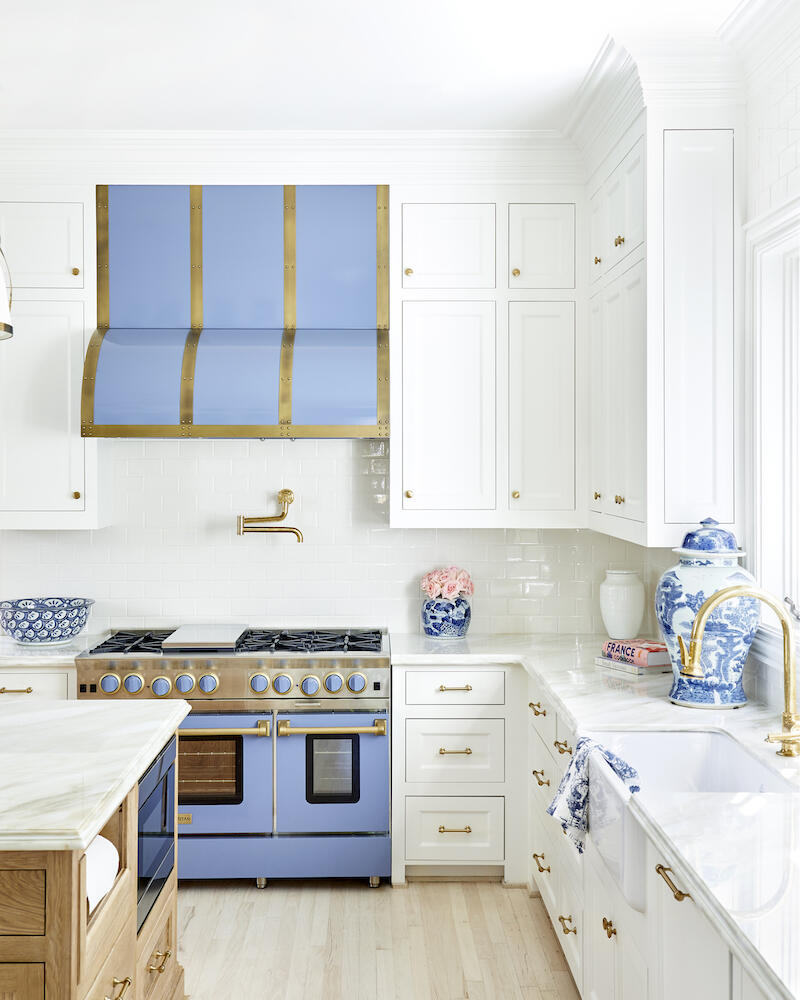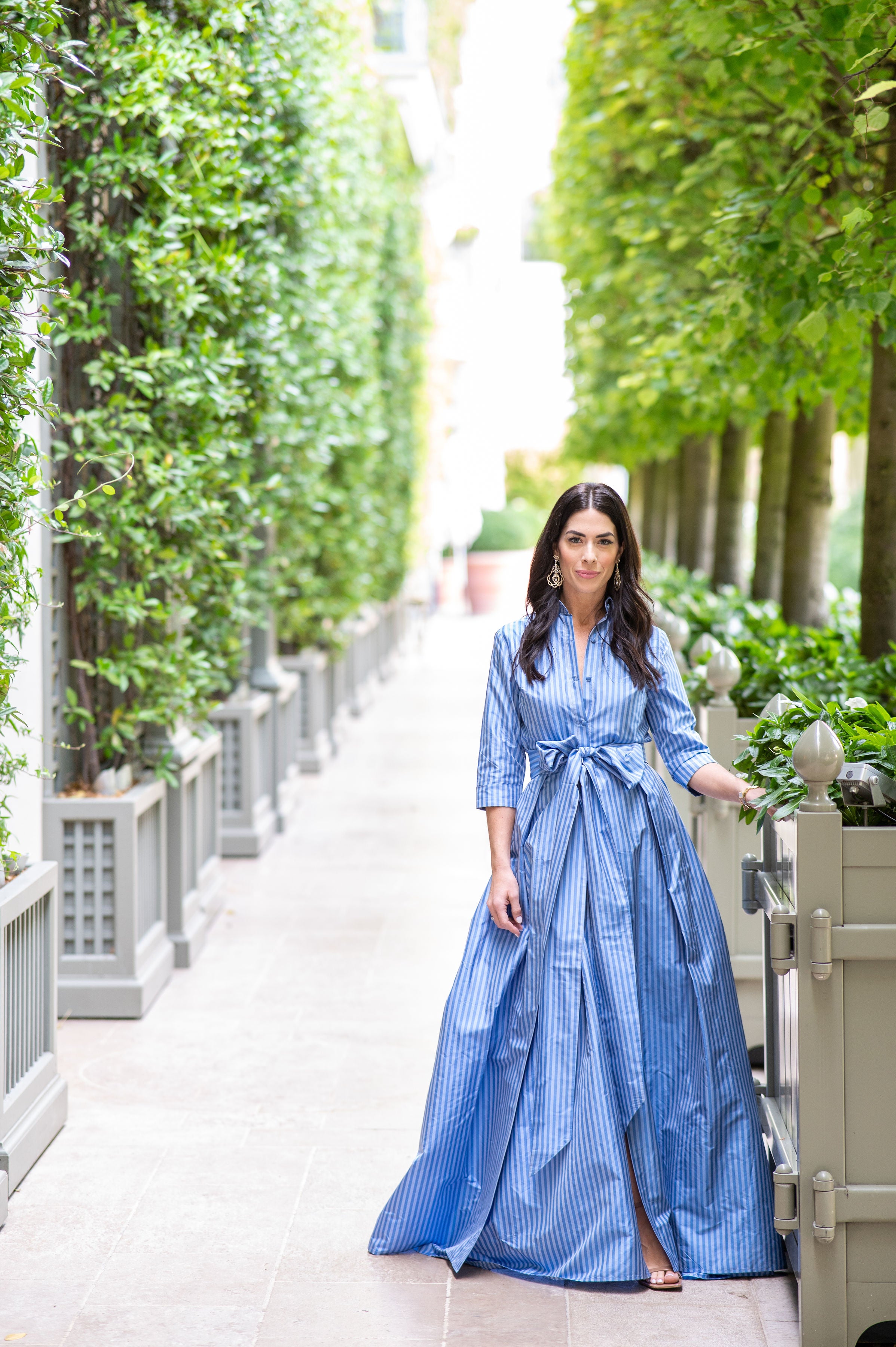In Ask an Influencer, Business of Home explores the creator economy. This week, we spoke with Caitlin Wilson, the interiors and textile designer behind the eponymous Instagram account and studio Caitlin Wilson Design.
On social media, Caitlin Wilson has attracted a cult following over the years for her traditional, feminine taste in interiors: all soft florals, pretty pastels and scalloped edges. As she explains it, there was once a time when she was just a college student with a penchant for home decoration—and then, she went to Paris.
“I became consumed with the aesthetic,” says Wilson. “I mean, just enamored with the style and the detail and the elegance—that’s what really sparked my personal style.”
That study-abroad experience set Wilson’s career on a new course. She wrapped up her degree at Brigham Young University and set off for New York, where she completed a summer design course at Parsons and promptly began taking on design clients while working part-time as a buyer for a retail decor shop. But still, the designer’s globe-trotting experiences had a habit of transforming her career path. As her husband’s job moved Wilson’s young family to Dubai and then Hong Kong, the designer transitioned her one-time wedding blog into a lifestyle- and design-focused document of her daily life.
More than a decade later, that decision to start a blog has transformed Wilson’s life and business. Today, she runs a variety of design-centric ventures—full-service projects, an e-commerce empire, a brick-and-mortar store in Dallas and a new book, Return to Pretty—while showcasing her aesthetic to an audience of 335,000 followers on Instagram.
Ahead, Wilson shares why she revived her personal Instagram account to offer followers a more intimate place to connect, how she nailed the lo-fi approach to video that works for her, and why she’s finally giving her audience a glimpse at her life’s imperfections.

When did you launch your design business and social media presence?
I launched my design business in 2007, pretty quickly after I graduated from college. It was actually through my blog, which was just what newlyweds did at the time: You start a blog, and maybe it’s for your wedding, but then it turns into your personal life. I don’t think people do that anymore because everyone has their own social media handles. I started sharing my newlywed apartment and I attracted some random people I didn’t know personally, and someone reached out to me and asked if I would help them decorate their house. I was so young that when she offered me like $65 an hour, I was like, “Yes, I will quit my job and work for you until your house is done!” I jumped into interior design and figured out how to make it work—it was very bootstrapped.
Three or four years later, I had a new baby and was living overseas with my husband in Dubai. I was looking for the next thing that I was going to do, because I was settled into my new life as a mom, and I was ready for something to focus on, so I transferred my personal blog into more of a design blog. I was writing about my experience living overseas and sharing lots of pictures of my life [abroad], and traveling with my baby and my husband. Then we moved to Hong Kong and spent six months there, which was really fun and exciting, and that’s where I decided I wanted to design textiles.
I’ve always had a passion for pattern and color, but it was more out of necessity because I was designing for people all over the world, taking on e-design clients in the U.S. and in Dubai and a few people in Hong Kong, and I physically could not get nice textiles there. I could get them to the people in Hong Kong, but there actually wasn’t a reliable mail system in Dubai in 2010. It seems kind of crazy, but I think I ordered some Kravet fabric for a client and it took three months to get there. What I realized was, “Oh, I actually have a real opportunity here. I can make textiles for my customers—they can use the fabrics and that can fuel a business, even if it’s very small.” Thanks to the blog world, I had people asking for these pillows that I was making with a workroom in Dubai, [using] a very simple application of trims on fabric—and then in Hong Kong, I [started] printing textiles. Over the course of a few months, I was like, “OK, I’m going to do this.” So in 2011, I launched the textile line.
How would you describe your content in those days, and how has it evolved?
I was writing mostly about personal experiences—projects I was doing, life as an expat, my travels. It was definitely a lot of me, and interestingly, it’s always been this combination of people wanting to see behind-the-scenes of my life or what I’m creating or doing. They were also very supportive and wanted the product that I was producing. A lot of it was instructional, too. I got married pretty young, so I was on a budget and painting chevrons on walls and doing lots of apartment-friendly types of things.
As soon as Instagram came out, it was like, “OK, well, this is different.” It didn’t require as much writing and time, but it was nice to quickly share, especially because I was so busy when I actually launched the collection. I had just moved back to the U.S. in 2011—my husband got into business school, and we moved to Philadelphia, so our lives were just totally crazy, but it was a really fun time. I was so lucky because it’s so much harder for businesses to break into social media now, and at the time, I don’t even remember how quickly my Instagram handle was growing, but it didn’t require that much effort. It was like, “Oh, just post a fuzzy picture of something and throw a filter on it.” But it was exciting—I was 25, and there were not a lot of designers selling textiles online and making it accessible for people. That was definitely the sweet spot, the void I was trying to fill. As a designer, I recognized how challenging it can be to actually get product and fabrics—at the time, you had to fax in an order. It was a different scene. And then getting it on to a website and making it a functional e-commerce site—because that was before Shopify—and you just had to wing it.
But it was so exciting to watch this come to life. I was the one packaging orders and cutting the swatches, and I had little babies at my feet and I was just making it work and making it happen. It was thrilling.
What does your business look like today?
I’m operating in a very limited capacity when it comes to interior design. I still take on a select clientele—a few every year—because I don’t have time to take on very many projects. I’m known for a specific color palette and I do things my own way, and if I don’t find what I’m looking for, I make it myself.
We’ve been in a phase of the business where we’re growing a lot and focused on new collaborations and licensing, and I’ve just finished my own home—a two-year remodel on a 100-year-old home. And then having just published my first book, Return to Pretty, that definitely paused everything, but it was really important to me, and it’s been great for the business and the brand. Servicewise, we also offer design stylists to help customers via email or via phone, or in person if you’re in Dallas, where our headquarters and flagship store are. The rest of the business is e-commerce—all the products we manufacture: rugs, wallpaper, pillows, fabrics and some private label furniture.

I will occasionally do sponsored content. I love to do it with fashion because I’ve always been the face of my brand—that’s what you get when you name your business after yourself. People started following me as a person, not really as a textile designer. Usually [covering my personal life] feels like a stretch on my Caitlin Wilson Design account, so in the last few years I’ve revived my personal account just to stay active, and as an author now it’s nice to have a different point of contact for people that may not want to be served as much marketing materials, but can find me more intimately as just Caitlin Wilson on Instagram. So I do a little bit more sponsored content on there.
I have also partnered with a lot of bigger name brands this year as I embarked on my house renovation, so they were really fun to work with. It’s been fun to dip my feet back into more of the influencer role from a design point of view. I don’t share too much; I don’t really get on camera and talk face to face all the time. I’ve always wanted to maintain a certain level of professionalism. I like being more of a design influencer and less of a typical influencer, mostly because it’s not what I solely rely on for income.
Tell me more about the difference between the content on your personal and professional accounts.
Well, I have five kids, and one of them is almost 14. It wasn’t going to ruin her life if she was on Instagram, but she’s more reserved and she’ll occasionally say, “Please don’t post this on Instagram.” So I try to be careful with my family. When I was living in a big city and my kids were younger, it made me more nervous to think about exposing them or sharing too much. I think we all have to be careful with that.
But more recently, I recognized that this could be fun if we don’t take it too seriously. Now I'm just winging it more. For so long, I was overthinking it. I was like, “Well, if I’m gonna be like a big designer, I have to be very classy and ensure that they don’t see what my real life looks like.” I was too stressed about people seeing the imperfection because I maintain such a put-together persona on my professional account. So I do let people in a little bit on Caitlin Wilson Design, and I definitely have played around with it. I’ve tested the waters here and there, and I realized that thankfully, people really do come to me as a brand for what I offer [in terms of products, aesthetic and design resources], and that’s great because that means that I don’t have to sell it personally for the rest of my life. That gives me a sense of freedom. I’m not doing it all the time every day; it’s just a fun complement to the brand.
It can definitely be hard on you mentally to do social media. That’s one of the risks for sure. With my children, that’s one of my fears—I don’t want them to be insecure or have mental health struggles because they’re growing up in this world with social media, with so much use of technology. So I realized that I have a real life, a real family and real kids, and they’re messy and I can’t do it all, and I think people appreciate that. I certainly appreciate the kindness and the support that I gained from that connection with my customers and clients and friends, so it’s a good support network for me. I’m grateful for it.
When did you start approaching social media with a strategy?
We’ve implemented more strategy [since building] a more advanced team, and I think Instagram itself has become more advanced in reporting and helping us analyze. We’re all trying to understand the algorithm. It’s a very complex system—with this crazy technology-driven world that we live in, especially now with AI, it’s like, who knows what we’re going to be doing next? We’ve definitely gotten more advanced in trying to understand [those analytics] because we don’t want to waste our time, and I only have so much time to even be at the office because of my family life and my other projects.
That’s where we analyze: What do people actually want to see; what do they want to know? How do they need help understanding our product; how do they want to be assisted in terms of utilizing it? What do they want to see in terms of our business and our brand? How do they want to know me better? What are they interested in seeing in my house or my personal life?
We definitely think about those things properly, but when we create, we also try to be more lighthearted, and I think people have definitely responded to the more casual nature in which we create content, specifically in video. I was intimidated by video at first, like, “No, this is not what I do. We take beautiful photos. No one has to be in them; I can be pregnant on the couch watching this photo shoot; I can be nursing a baby or be on the go, take this photo and post it.” But now, not only are there Stories that are more active and everyday behind-the-scenes; there are also Reels that sometimes are like a live-action, Broadway musical. None of us went to school for that. We trained to be designers, and if we did have hard-core training, it was on AutoCAD or in accounting or QuickBooks.
But now that I have embraced [the video process], it makes it so much more fun. Employees of mine get really into it—like, we did a warehouse sale, and they made me stand on the street with this spinning sign. I am confident enough to be like, whatever, this is fun, our customers appreciate it. And we had a great day. You have to add up all the fun—the fun memories and fun days—and you have to make life and work fun.
That’s probably what I pride myself on the most when it comes to my business: At the end of the day, did I make a difference? Did I help people access something that made their lives easier or happier? For me, it’s the creation of the product and making it more simple and straightforward for people to decorate their homes, and putting confidence in them that they can put together their home with an aesthetic that’s going to be cohesive.

What does your social media team look like?
There were times when, to me, the most daunting task was social media. It was kind of like, if anyone can take this off my plate, just do it, I don’t care what the post says—although I’ve always cared what the image looked like and how the images complement each other. I’ve always had some type of support in creating the [social media content] plan, the order, executing it, getting it posted. Now I have a marketing director that puts together the editorial calendar based on sales and seasonal events. Then I have a marketing manager in addition to [handle] other responsibilities involving e-commerce—she does the scheduling and [coordination of] collaborative posts. I’ve had people who’ve helped me with the writing, but I always edit things, so I still kind of tweak all the copy. And then Stories are intertwined with a graphic designer.
On the personal side, I always throw a curveball in because I’ve gotten to a point where I don’t care what people think as much. It’s important not to do anything inappropriate or cross the line, and I don’t get political on either of my accounts—and sometimes, I get in trouble for not being political, too. But I just really want to inspire people in a creative way, and that’s why I always tell people, “I am not an influencer. I am a designer.”
When you began to build a following, did your life change at all?
It’s interesting because the business and the following really grew together. My life changed all of a sudden when I realized that I had this power to have a business and create a brand. That felt so magical. It took several months and a lot of back-end work and troubleshooting and fixing, but when it all went live, it was this moment when I realized that I could do anything. Now it probably doesn’t feel as much that way when someone launches an online business, but at that time, it felt like the world was my oyster. It was like, “Oh, my gosh, I can create a business online, and I can write whatever I want on it.” That set me on this path where we can do anything we put our minds to, which sounds so cliché, but it’s true. You don’t have to be an artist, but [you have] to think creatively and use your mind and your work ethic and be resourceful and find a way to do that thing that you’re passionate about, and share it with the world, which is essentially social media.
It’s important to recognize that as designers, tastemakers and influencers, we have a certain level of responsibility to cast a positive light on that influence or role—we can be good examples. We can be good influences. We can be mentors. We can be teachers and we can help. It’s not only important to build that design community as a whole, but to be a more positive environment, and to lift each other up and to be positive and supportive. It’s kind of cheesy, but I love that quote: A rising tide lifts all boats. Also, as a mother, I really care that I show my children and other young people that you can do really good things with social media, and you can also do really bad things on social media, and you have to be careful. But I’m really grateful to have had the experience of seeing how it’s played out in my life. If you’re careful, thoughtful and authentic, it can really pay off.
What’s the biggest thing you’re struggling with today on social media?
The algorithm is just a mystery. I can’t think about it anymore. The thing we struggle with most is the inconsistency. You can’t plan anything—[in terms of] what’s going to work, or even just marketing tools like SEO and advertising—there’s just so much just constantly changing because of technology. The power that it has over our small businesses is really scary. I think we’re struggling to know, for example, should we really be creating as many wallpaper patterns this year? Who knows if we’re going to create every wallpaper under the sun, and then our wallpaper sales are going to be down. I think it’s important to be flexible and be ready to pivot. We’re keeping things lean and not investing too much in one thing and being creative. That’s the benefit to being in this design world—what comes with being a designer is creativity.
Homepage image: Caitlin Wilson | Katie Nixon





























